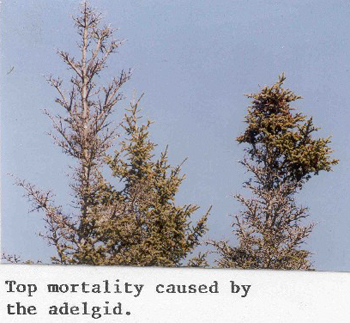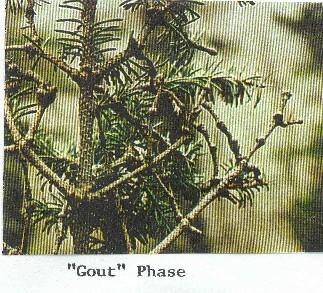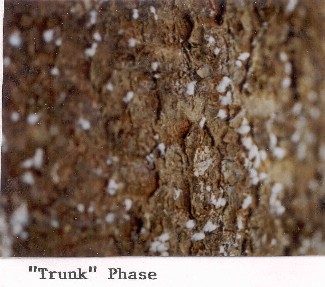DACF Home → Bureaus & Programs → Maine Forest Service → Forest Health & Monitoring → Forest Pest Index → Balsam Woolly Adelgid
BALSAM WOOLLY ADELGID ALERT

The balsam woolly adelgid (BWA), Adelges piceae (Ratz.) has been very abundant in the last several years in Maine and feeding activity by this pest has resulted in serious injury to or death of large volumes of balsam fir. BWA is an introduced pest of true firs that has spread throughout the southern half of the State. Entire stands of mature balsam as well as understory fir have been killed in many areas of the state and salvage operations are planned. While the heaviest damage has occurred within 30 miles of the coast, damage may also be seen as far north as southern Aroostook, northern Penobscot and southern Piscataquis counties. While balsam woolly adelgid is frequently limited by cold winter temperatures, the mild winters of the 1990's and early 2000's allowed this pest to attain damaging levels.

The life cycle of this pest is very complex but it is most commonly observed as either the "gout" phase or the "trunk" phase. The "gout" is a heavy swelling of the twigs at the nodes and is actually a response from the host tree to chemicals injected by the insect when feeding. The reaction causes increased cell growth resulting in a swelling of the twig nodes. This swelling can cause the distal portion of the twig to die due to impairment of the vascular system. Several successive years of this damage may kill the entire tree. The "trunk" phase is characterized by the presence of white woolly spots or patches on the tree bole which, in severe cases, may cover most of the trunk. Various stages of the adelgid are present under the woolly material feeding through the bark. Although landowners may observe scattered cases of light trunk phase, the majority of damage currently seen in Maine is the result of the gout phase.

Landowners are urged to examine balsam fir on their lands and harvest damaged trees in a timely manner to salvage the value. Contact the Maine Forest Service for assistance in assessing damage and making informed management decisions.
For More Information:
USFS FIDL
(pdf)![]()
BugWood Wiki![]()